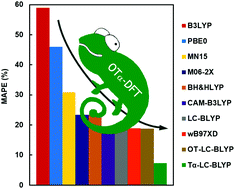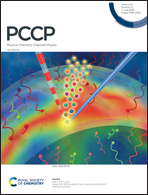A new tuned range-separated density functional for the accurate calculation of second hyperpolarizabilities†
Abstract
The calculation of nonlinear optical properties (NLOPs) using density functional theory (DFT) remains a challenge in computational chemistry. Although the existing range-separated functionals display the best performance for the calculation of this type of properties, their errors strongly depend on the family of molecules studied. Herein, we have explored a new strategy to empirically tune the range-separated LC-BLYP method to improve the accuracy of the calculation of the second hyperpolarizabilities (γ), which are poorly described by current density functional approximations. First, we benchmarked nine of the most accurate commonly used range-separated hybrid and optimally tuned functionals (i.e. B3LYP, PBE0, BH&HLYP, M06-2X, MN15, ωB97X-D, CAM-B3LYP, LC-BLYP and OT-LC-BLYP) for the calculation of γ using as a reference the CCSD(T) values of a chemically diverse set of 60 molecules. Among these nine functionals, LC-BLYP gives the lowest average errors. We determined the value of the range-separation parameter ω required to reproduce the CCSD(T) second hyperpolarizabilities with the LC-BLYP functional (ωCC) for the set of 60 molecules. Our new tuned range-separated functional, Tα-LC-BLYP, uses a quadratic correlation between ωCC and a molecular descriptor in terms of the linear polarizability and the number of electrons in the molecule. The average error of the γ values obtained with Tα-LC-BLYP is reduced by half or more as compared with the most accurate among the nine density functional approximations benchmarked.

- This article is part of the themed collection: 2020 PCCP HOT Articles


 Please wait while we load your content...
Please wait while we load your content...